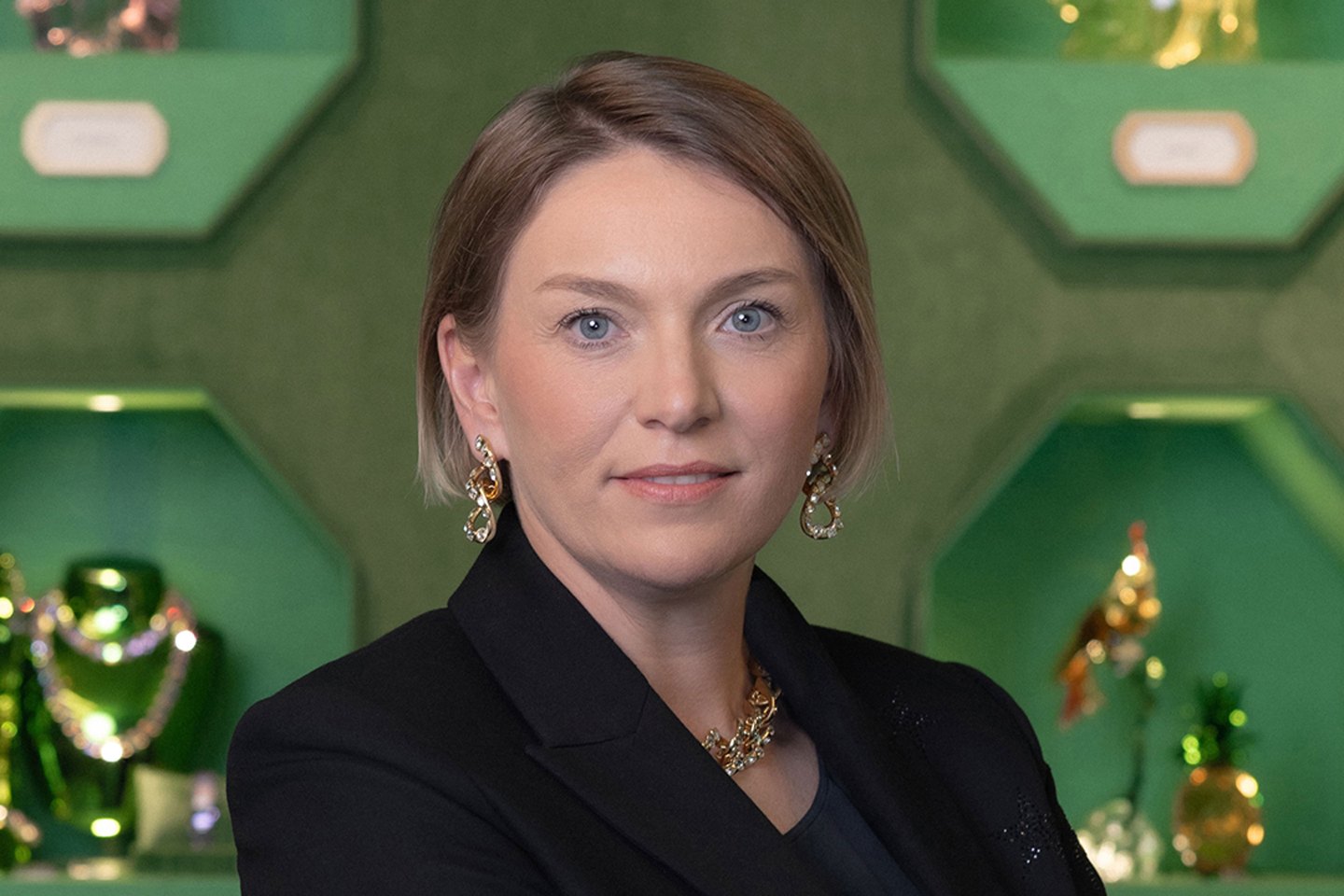While studying at the University of Vienna, Lea Sonderegger’s PhD research focused on omnichannel retail, arguing that consumer spending would increasingly blend across the physical and digital worlds.
“At the time, omnichannel was just a concept on paper,” says Sonderegger, who completed her studies at the University of Vienna in 2010. “Nobody believed that people would buy online and actually pick up the stuff in a store.”
It proved to be a prescient pitch that caught the attention of Swarovski, who hired Sonderegger 15 years ago to serve as an e-business project manager for the luxury jewelry retailer. Today, three out of every four American shoppers are omnichannel, accounting for 27% of total retail spending, according to research published by credit-card giant Capital One.
Over the course of her technology career at the crystals and gemstones manufacturer, Sonderegger has risen up the ranks, taking on increasing responsibilities that included oversight of the main e-commerce business for swarovski.com, operations in China, and eventually a successor for the chief information role that would be combined with the chief digital officer title in 2022.
Sonderegger reports directly to CEO Alexis Nasard and sits on Swarovski’s executive committee, a prime position that reflects the importance of digital commerce as a core pillar of Nasard’s “LUXignite strategy,” which the executive unveiled in 2022 that included a focus on opening new flagship stores, including a shop on New York’s Fifth Avenue that opened in late 2023. He also lauded a commitment to investing in digital experiences, a key modernization effort for a brand that began in 1895.
Reporting to Nasard, Sonderegger says, “makes a huge difference, because I’m sitting [at] the table with all of my executive committee peers and digital is right at the place where all the things are decided and driven.”
Sonderegger says despite its long history, Swarovski has always been an early adopter when it comes to consumer-focused technologies. The company opened a web-based online shop in 2001, then a mobile website in 2010 and an online store two years later. Today, 80% of the company’s online transactions come via mobile.
As consumer shopping patterns have migrated online, Swarovski’s approach has evolved. The company now offers “to “buy online, pick up in store” and even a service that allows shoppers to order something from a local shop and have it shipped to their home within a single day.
The retailer has credited the “LUXignite” strategy for why the company reported a 6% increase in revenue for the fiscal-year 2024, as well as an operating profit that was fully positive for the first time in five years.
“We’ve always started with the customer at the center, and that’s helped us,” says Sonderegger. “We never started with, ‘Oh, that’s the newest, coolest technology.’”
Sonderegger says there’s been a lot of internal curiosity and excitement among Swarovski’s employees for new generative artificial intelligence tools. “I would say close to zero pushback from anybody, across the organization, towards gen AI,” she says.
A few of Swarovski’s generative AI applications in production today include a tool that helps customer service representatives handle client questions, which has reduced the response time of those agents by 55% and boosted the company’s net promoter score, a metric that tracks how likely shoppers will recommend a brand or service.
AI has also lifted Swarovski’s demand planning accuracy by 15%, giving the retailer greater insight to predict future shopping patterns, which can then help it better plan supply levels. In marketing, A/B testing showed that AI-written personalized newsletters got four times the response rate from customers than messages sent without the technology.
Sonderegger says she hasn’t been locked in on any one single vendor relationship throughout Swarovski’s AI journey, though Google and SAP were named as two key partners. “I’m very challenging towards all of the vendors,” she adds. “Some of them obviously generate value, but throwing out AI as a verb is definitely not enough.”
Swarovski’s test-and-learn approach to technology has helped it avoid spending too much money on earlier forms of technology that later lost their shine. Several years ago, a test of a virtual try-on tool didn’t move beyond the pilot phase because the technology wasn’t sharp enough.
But Sonderegger says she’s currently exploring virtual try-on again, which is expected to launch early next year. And she can do so because Swarovski was cautious during its earlier attempt.
“I really like this piloting and testing approach, rather than going in with huge technologies and then finding out it’s not working,” she says. “Then, it’s very hard to convince for the next time.”
John Kell
Send thoughts or suggestions to CIO Intelligence here.
NEWS PACKETS
Nvidia’s multi-billion-dollar spending spree. The AI chip making behemoth has been writing checks for billions over the past week, including a vow to invest up to $100 billion in OpenAI, a strategic investment that will allow the ChatGPT developer to open data centers with Nvidia’s semiconductors. Four days earlier, Nvidia announced it would invest $5 billion in Intel’s stock, a move that The Wall Street Journal and other outlets have reported as a victory for Intel CEO Lip-Bu Tan, as he attempts to navigate a turnaround effort for the beleaguered semiconductor manufacturer that’s also been backed by the Trump administration. And in yet another deal, CNBC reported that Nvidia spent over $900 million to hire Enfabrica CEO Rochan Sankar and other employees at the AI hardware startup, a deal that will also allow it to license Enfabrica’s technology.
Oracle names two insiders to serve as co-CEOs. Software giant Oracle appointed Clay Magouyrk, president of Oracle’s cloud infrastructure division, and Oracle Industries President Mike Sicilia to serve as the company’s new CEOs, taking the reins from Safra Catz, who ranked 14th on Fortune’s 2025 Most Powerful Women list. The leadership change comes as Oracle’s shares have bounced higher as investors have cheered the company’s AI efforts, including big client wins from xAI and Nvidia, and partnerships with AI hyperscalers including Microsoft and Google. And while having two CEOs is fairly rare, Fortune reports that the average co-CEO tends to last longer on the job than solo counterparts and perform better when it comes to generating shareholder returns.
Workday’s big bet on AI agents. Agentic AI saw another big tech launch, this time from business software provider Workday, which debuted new HR and finance agents in collaboration with Microsoft to perform tasks autonomously. Workday also debuted a developer program, a low-code tool called the Workday Flowise Agent Builder, which will allow customers to build and manage their own custom AI agents. CEO Carl Eschenbach told Wall Street Journal that companies were having a difficult time justifying the spend on AI agents. “We’re taking a very targeted approach: We have the cleanest set of data that’s highly curated for HR and finance,” he said. Separately, Workday agreed to buy Sana for around $1.1 billion, as deal-making ramps up for HR-focused software.
AI spending is projected to reach $1.5 trillion globally in 2025. Research firm Gartner has estimated that the total AI market will grow by 50% this year and could exceed $2 trillion in 2026, as AI hyperscalers spend big on data centers and AI-optimized graphics processing units and AI accelerators. Beyond the big spending from hyperscalers like OpenAI, Google, and Microsoft, investments are also coming from markets outside the U.S., including China, as well as new AI cloud providers and venture capital investments that are providing a tailwind to the AI boom. Next year's lofty growth is expected to come from further AI integration into smartphones and PCs, in addition to more spending on infrastructure.
ADOPTION CURVE
Larger organizations—and their workers—are increasingly embracing AI agents. 42% of companies have launched at least some AI agents, nearly quadrupling the deployment from two quarters ago, according to KPMG’s Q3 AI pulse survey of 130 U.S.-based C-suite and business leaders at firms with annual revenue of $1 billion or more. The most active use of AI agents are in IT/technology (95%), operations (89%), and risk management (66%), while marketing and sales (18%) and human resources (2%) lag far behind.
“There’s for sure a shift as the level of anxiety about engaging with technology in a new and different way has started to subside for a large swath of the employee population,” Rahsaan Shears, a principal at KPMG, tells Fortune.
The accounting giant says that employee resistance to AI and agents has dropped from 47% to 21% in a single quarter, with 55% of the workforce either accepting or actively embracing AI agents. Hiring is also expected to be affected, as a majority of leaders (56%) anticipate they will adjust their entry-level recruiting practices within the next year.
Courtesy of KPMG
JOBS RADAR
Hiring:
- American Financing is seeking a CIO, based in Aurora, Colorado. Posted salary range: $200K-$300K/year.
- WiderOrbit is seeking a SVP of engineering, based in Dallas-Fort Worth. Posted salary range: $180K-$220K/year.
- The Nuclear Company is seeking a CTO, based in Lexington, Kentucky. Salary range undisclosed.
- Illinois Department of Innovation & Technology is seeking a CIO, based in Springfield, Illinois. Posted salary range: $125.8K-$136.2K/year.
Hired:
- Nokia has appointed Pallavi Mahajan to the role of chief technology and AI officer, joining the Finnish telecommunications company after previously serving as VP and general manager of data center and AI software at Intel. Mahajan also held several leadership technology roles at IT provider Hewlett Packard Enterprise and wireless-network provider Juniper Networks, which HPE acquired earlier this year.
- Hitachi Vantara Federal named Majed Saadi as CTO, overseeing the technology strategy for the IT services provider that focuses on the federal government. Previously, Saadi held leadership roles at IT services providers including Synergy, General Dynamics Information Technology, and Govplace.
- Valeris appointed Manish Goel as CTO, where he will steer global technology initiatives focused on innovation and improving patient outcomes for the pharmaceutical industry services provider. Prior to joining Valeris, Goel held senior technology roles at several healthcare and tech companies, including Mercury Healthcare and Oracle.
- Lakeside Software announced Aleksey Shafransky as CTO, where he will oversee technology and product engineering for the IT management software provider. Shafransky joins Lakeside from Kaseya, which also sells IT management software, where he served as SVP of research and development.
- Ranchbot Monitoring Solutions named Davide Defendi as the ag-tech company’s new CTO, where he will lead production development and the IT functions in the U.S. and Australia. Ranchbot said the hire comes as the company prepares for its Series B capital raise. Defendi has previously founded six startups, taking three of those public.













